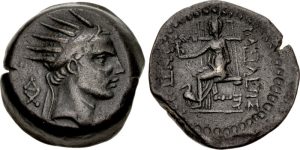Background to Hanukkah: Inscription Reveals Roots of Maccabean Revolt, Hershel Shanks, Biblical Archaeology Review (34:6) Nov/Dec 2008.
A major new inscription that recently surfaced on the antiquities market and has been acquired by the Israel Museum in Jerusalem sheds dramatic new light on the run-up to the Maccabean revolt in the second century B.C.E.
Until now, almost everything we know about the Maccabean revolt, which freed the Temple from the desecration of Antiochus IV Epiphanes (the successful campaign to cleanse the Temple is still celebrated by Jews in the festival of Hanukkah), comes from the writings of Josephus and the books of 1 and 2 Maccabees (apocryphal in Protestant and Jewish tradition and deutero-canonical in Roman Catholic tradition). The new inscription, however, provides a more realistic context to some important history of that period.
The stone stela on which the inscription is written is nearly 3 feet high. The top of the stela features a point or gable on each end, with a larger, higher point in the middle. Beneath this central point is an engraved rosette still covered in red paint. The language of the inscription is Greek. Unfortunately, the bottom part of the stela has broken off. But 23 full lines of writing have survived, plus a few more partial lines at the bottom.
Read the rest of Background to Hanukkah: Inscription Reveals Roots of Maccabean Revolt in the online Biblical Archaeology Society Library.




